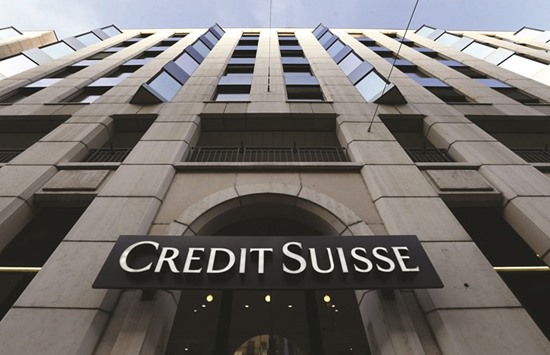Credit Suisse Group, seeking to free up capital while immersed in a costly overhaul, is pitching a plan to farm out some of its risk from potential losses linked to events like rogue trading and cybercrime, people with knowledge of the matter said.
The bank has approached bond investors, hedge funds and asset managers in recent months with the design for an instrument akin to catastrophe bonds that would cover operational losses between 3.5bn Swiss francs ($3.6bn) and 4.2bn francs, four people said, asking not to be identified because talks are private. The insurance industry uses so-called cat bonds to limit exposure to disasters such as hurricanes and earthquakes. Investors get above-market yields for taking a chance on their money being wiped out.
The Swiss bank “would be the first to issue this kind of an investment to my knowledge,” said Jean Medecin, a member of the investment committee at Carmignac, a Paris-based asset manager that oversees €52bn ($59bn) in assets. “If Credit Suisse succeeds with such an offer, more banks will follow suit.”
Reducing risk has been a priority for Chief Executive Officer Tidjane Thiam, a former insurance executive who took over last year shortly before Switzerland stepped up capital requirements. Regulators require banks to hold funds as a safeguard against various kinds of vulnerability, leaving them with less money to build the business.
The security offered by Credit Suisse would be a two-tranche structure underpinned by a policy with Zurich Insurance Group worth 700mn francs, the people said. They said the insurer would retain 10% of the risk, with the rest packaged in a five-year bond and sold to investors via a Bermuda-based vehicle. The senior, less risky slice may carry a coupon of 4%, the people said.
Credit Suisse is seeking to place the bond after first-quarter earnings on May 10, assuming it has received regulatory approval and there is sufficient interest. Both the size of the issuance and the coupon could still change, the people said.
The bank declined to comment, as did Finma, the Swiss financial regulator. Zurich Insurance’s “policy is not to comment on current or potential commercial relationships,” Pavel Osipyants, a spokesman for the insurer, said in an e-mailed statement.
Zurich said in 2013 that it was developing a capital-relief product for operational risk and planned to start selling it by the end of 2015. Operational risk describes the potential for losses from external events and from failed internal processes, a broad category that includes fraudulent transactions, trade processing errors, business disruptions, failures in regulatory compliance and unauthorised trading.
Credit Suisse reported about 66bn francs in assets weighted for operational risk in 2015, up from 58bn francs in 2014. That represents about 22% of its total risk-weighted assets, the second-largest pool after credit risk. Whether investors will embrace the deal remains to be seen. Some questioned whether it’s possible to quantify risk from events like cybercrime where losses can be difficult to anticipate and model. Others worry the bond would react to the bank’s stock movement, although such securities are designed not to mimic markets.
Credit Suisse’s shares have lost 31% of their value this year, as write-downs on illiquid trading positions and a selloff in bank stocks compound doubts about Thiam’s restructuring plans.
The offering “could be an intelligent way to reduce capital,” said Andreas Brun, an analyst at Zuercher Kantonalbank who has a market perform rating on the stock. “But who would decide whether something was an operational risk or credit risk?” Under Thiam, Credit Suisse is restructuring to concentrate on wealth management, which carries less risk than investment banking. Credit Suisse tapped investors for about 6bn francs in October and is planning to sell part of its Swiss business to raise more funds.
Operational hazard became a reality in the fourth quarter when clients including the ex-prime minister of Georgia -bnaire Bidzina Ivanishvily - withdrew 1.5bn francs over unauthorised trades by a former bank adviser. The bank has set aside 250mn francs for litigation related to the case, people familiar with the situation have said.
Such threats entered the global regulatory debate after the 1995 collapse of UK bank Barings following a trader’s losing bets on derivatives. UBS Group, Switzerland’s largest lender and Credit Suisse’s competitor, lost $2.3bn on unauthorised trading by Kweku Adoboli in 2011. Bruno Iksil, the former trader known as the London Whale, lost at least $6.2bn for JPMorgan Chase & Co in 2012.
Credit Suisse’s plan is “an innovative approach to capital management,” said Urs Ramseier, CEO of investment manager Twelve Capital. “The idea could be capital arbitrage.” By going through an insurer, the bank may benefit from lower capital requirements for that industry, he said.
Regulators are sure to take a close look, said Neil Smith, a Bankhaus Lampe analyst, recalling that the 2008 financial crisis stemmed in large part from banks transferring risk to insurance companies.

A logo is seen on a branch of the Credit Suisse in Geneva. Credit Suisse is pitching a plan to farm out some of its risk from potential losses linked to events like rogue trading and cybercrime, according to reports.


